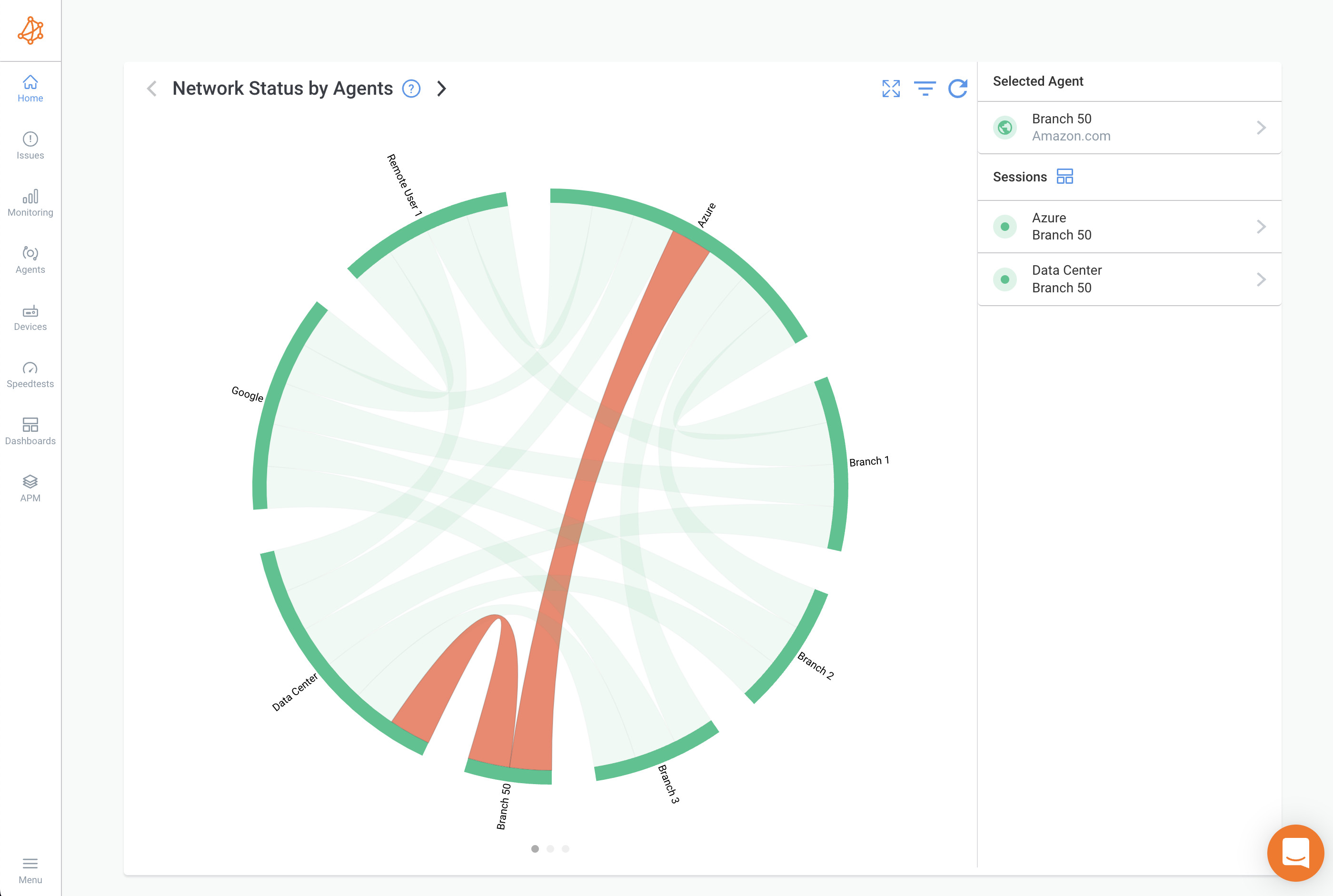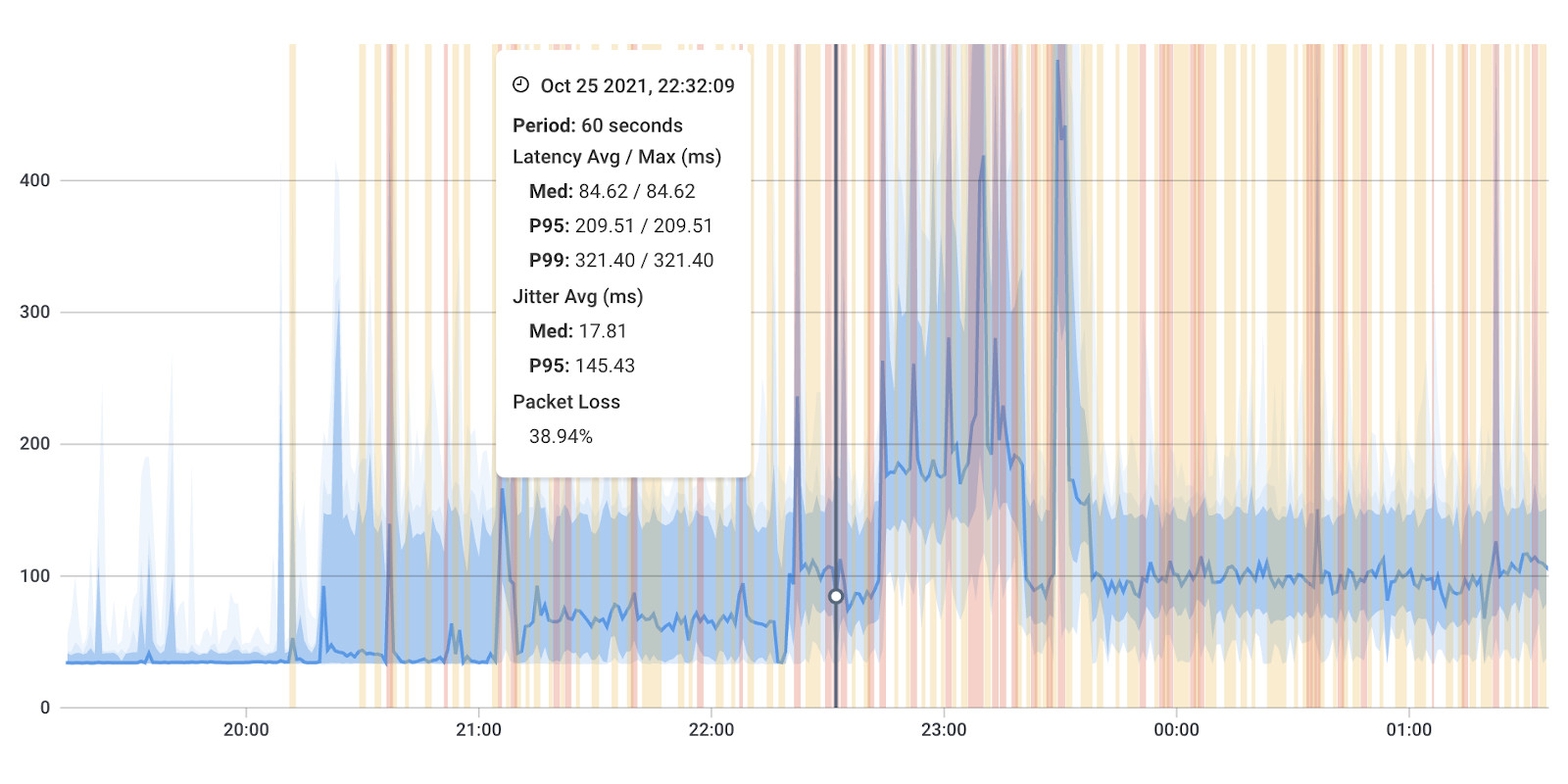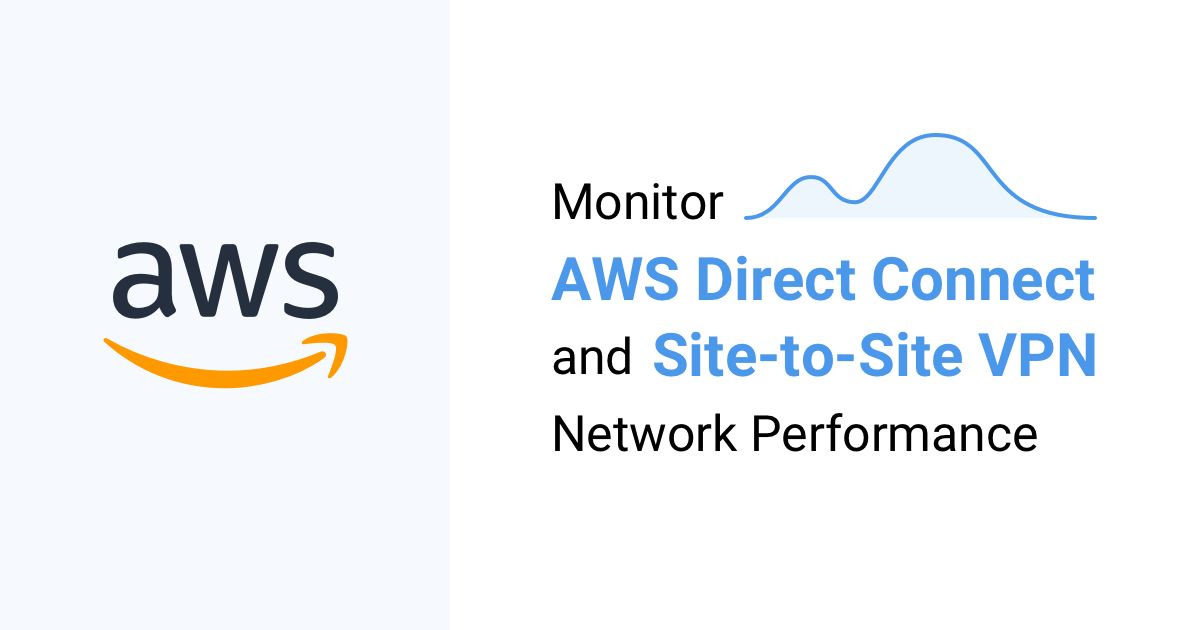Table of Contents
Table of Contents
Are you ready to set sail on a journey to reliable connectivity with Microsoft Azure ExpressRoute monitoring? Just like navigating the seas, sailing in the cloud can be a bumpy ride if you don't have the right tools to keep your ship on course. But fear not, because we're here to help you chart a course to success with Azure ExpressRoute monitoring!
Whether you're a seasoned sailor or a landlubber just starting out in the world of cloud computing, monitoring your Azure ExpressRoute connectivity is essential to ensuring smooth sailing. In this blog post, we'll dive into the importance of Azure ExpressRoute monitoring, how to monitor Microsoft Azure ExpressRoute performance between your on-premise infrastructure, up to the Microsoft cloud. We'll also and share some tips and tricks to help you keep your ship on course and avoid any potential storms along the way and to ensure that you never lose connection with your favourite Microsoft services.
So, hoist the anchor and let's set sail on this adventure to reliable connectivity with Azure ExpressRoute monitoring!
Azure ExpressRoute is a service offered by Microsoft which allows you to create private connections between your on-premise networks and Microsoft cloud using a private connection facilitated by a connectivity provider. With Azure ExpressRoute, you can establish connections to Microsoft cloud services, including Microsoft Azure, Office 365, and Microsoft Dynamics 365.
Connectivity can be established from an any-to-any (IPVPN) network, a point-to-point Ethernet network, or a virtual cross-connection through a connectivity provider at a co-location facility.
Azure ExpressRoute connections don’t go over the public Internet, which offers users higher security, reliability, and speeds with lower latencies than typical connections over the Internet. This is highly beneficial for users that require a connection speed and reliability for Azure assets or an entire Azure infrastructure.


Smooth sailing in the cloud requires reliable connectivity between your on-premises infrastructure and your Azure resources. But how can you ensure that your Azure ExpressRoute connection is always up to par? That's where monitoring comes in! By monitoring your Azure ExpressRoute, you can navigate through potential connectivity issues, optimize your performance, meet your SLAs, and enhance your network security.
You may already have some kind of monitoring system in place that probes your devices and alerts you if the device connection is down or if the CPU usage is too high. While a monitoring system of that kind is beneficial, and definitely something that you should hold on to, what happens if your provider, or third-party connector solution, begins to experience issues such as network congestion or packet loss?
When that happens, most users rarely have tools in place to monitor these systems from end-to-end. And uou don’t want these issues to go unnoticed until they wreak havoc on your network infrastructure. That's where network performance monitoring can help:

In this section, we'll dive deeper into the importance of Azure ExpressRoute monitoring and explore some of the key benefits it provides. Whether you're just starting out in the world of cloud computing or you're a seasoned sailor, understanding the importance of Azure ExpressRoute monitoring is essential to ensure that you're able to maintain smooth sailing in the cloud.
- Identifying Connectivity Issues: With Azure ExpressRoute monitoring, you can quickly identify connectivity issues between your on-premises infrastructure and Azure resources. This allows you to proactively troubleshoot and resolve issues before they impact your business operations.
- Optimizing Performance: Monitoring Azure ExpressRoute can help you optimize your network performance by identifying areas of your network that may be experiencing congestion, packet loss, or other performance issues. This enables you to take proactive measures to improve performance and ensure a smooth user experience.
- Meeting Service Level Agreements (SLAs): Azure ExpressRoute monitoring helps you meet your SLAs by providing real-time visibility into your network performance. This allows you to monitor and track performance metrics such as latency, bandwidth utilization, and packet loss, and ensure that you're meeting your contractual obligations.
- Improve End-User Experience: One of the key benefits of Microsoft Azure ExpressRoute Monitoring is improving the user experience. By continuously monitoring the network performance, you can detect and address any network issues that may impact the user experience. For example, if there is high latency or packet loss, it can cause slow application performance and impact the user experience. By monitoring these metrics, you can proactively address the issue and ensure a smooth and seamless user experience.
- Identify Issues in Azure's Network: Another benefit of Microsoft Azure ExpressRoute Monitoring is identifying network issues in the Azure network. As your organization's network infrastructure grows, it can become increasingly complex, making it difficult to identify and troubleshoot issues. With ExpressRoute Monitoring, you can monitor critical network metrics such as latency, bandwidth, and packet loss to detect any issues that may arise. This allows you to identify and resolve network issues quickly, reducing downtime and minimizing the impact on business operations.
- Enhancing Security: Monitoring Azure ExpressRoute can also help you enhance your network security by identifying potential security threats and vulnerabilities. This allows you to take proactive measures to mitigate risks and ensure that your network is secure.
Are you prepared to optimize your network and Cloud performance to new heights? Don't let anything hold you back from reaching the networks clouds.
And let Obkio guide you towards optimized Microsoft Azure ExpressRoute performance.

- 14-day free trial of all premium features
- Deploy in just 10 minutes
- Monitor performance in all key network locations
- Measure real-time network metrics
- Identify and troubleshoot live network problems

Network performance plays a critical role in ensuring the reliability and performance of Microsoft Azure ExpressRoute. Which is why Cloud Network Monitoring is essential! Here are some ways in which network performance can impact Azure ExpressRoute:
- Latency: High latency can lead to slow response times and poor application performance, especially for applications that require real-time interactions. Azure ExpressRoute uses dedicated connections to Azure, which can help reduce latency compared to public internet connections. However, network performance issues such as congestion or packet loss can still impact latency and cause performance issues.
- Bandwidth Utilization: Azure ExpressRoute provides dedicated bandwidth for connecting to Azure services, which can help ensure consistent and reliable performance. However, if the bandwidth is not sufficient to handle the traffic, this can lead to slow application performance and connectivity issues.
- Packet Loss: Packet loss can occur when packets of data are dropped due to network congestion, network errors, or other issues. This can impact the performance of applications and services that rely on the network, including Azure ExpressRoute.
- Jitter: Jitter refers to the variability in the latency of packets as they traverse the network. High jitter can cause issues with real-time applications such as video conferencing or VoIP, and can impact the performance of Azure ExpressRoute.
Whether you're a seasoned sailor or just starting out in the world of cloud computing, understanding the importance of network performance monitoring is essential to ensure that you're able to navigate through potential performance issues and maintain smooth sailing in the cloud.
If you want to make sure your Microsoft Azure performance stays smooth sailing, you'll want to have the right tools at your disposal. That's where a tool like Obkio Network Performance Monitoring comes in!
With Obkio, you can leave the monitoring to us - we'll continuously monitor your end-to-end network performance and identify any network issues for you. It's quick, easy, and ensures you're always aware of how your network is performing. So why spend all your time scanning for network problems when Obkio can do the work for you? Sit back, relax, and let us help you navigate through any potential performance issues on your journey to the cloud.

If you want to keep your network sailing smoothly like a true sailor, you'll want to make sure you're monitoring every inch of it. Just like a seasoned sailor charts their course to avoid hazards in the sea, you need to chart your network to avoid any potential issues!
That's where the Network Monitoring Agents come in! Obkio's Monitoring Agents are deployed at key network locations to keep a watchful eye on every part of your network. Whether you're monitoring WAN, LAN, or network devices, our agents will continuously monitor performance between them, ensuring that you're always aware of how your network is performing.
So why risk running aground when you can have the peace of mind of knowing that your network is always being monitored? With Obkio's Network Monitoring Agents, you can chart your network course with confidence and enjoy smooth sailing all the way!
When you're deploying your Azure ExpressRoute monitoring setup, we want to monitor the network performance between the Microsoft Azure Cloud and the on-premise infrastructure. To do, you'll need to deploy two Monitoring Agents (at the very least):
- Microsoft Cloud Agent: The Azure Monitoring Agent is hosted and maintained by Obkio in the Microsoft Azure cloud infrastructure. It allows you to proactively monitor network performance between your local network to the Amazon Web Services network. They provide complete and continuous visibility so you can easily identify the source and cause of Azure ExpressRoute network issues based after your network performance and Azure ExpressRoute performance.
- On-Premise Agent: These Monitoring Agents are deployed in your local network, in key network locations like your head office, branch office, data centers and network devices. They allow you to monitor network performance from your end. We recommend the Software (Linux, Windows, Docker) agent that can be installed on your favorite Linux distribution, including Amazon Linux and Amazon Linux 2.

P.S. You can also use the Azure Agent to monitor Microsoft Teams performance.
Once you’ve installed your monitoring agents at your chosen locations, you’ll need just two configurations which are required in the Obkio App:
All your network monitoring agents must be in the same Network. When two agents are in the same Network, they’ll communicate using private IPs instead of Public IPs.
You also need to configure a Network Monitoring Template to create the network performance monitoring session.
That's it! It's as simple as that. Now, the Monitoring Agents will exchange synthetic traffic every 500ms to measure Azure ExpressRoute metrics and network metrics to give you an overview of your network performance, and identify any issues affecting your Azure ExpressRoute service.
There are several important network metrics that should be monitored for Azure ExpressRoute to ensure optimal performance. Here are some of the key metrics to monitor:
- Latency: The Latency metric measures the time it takes for data to travel from one point in your network to another. High latency can lead to slow application performance and connectivity issues.
- Bandwidth utilization: This measures the amount of data that is being transmitted across your network, therefore your bandwidth. High bandwidth utilization can lead to congestion and slow down network performance.
- Packet Loss: The Packet Loss metric measures the number of data packets that are lost during transmission. High packet loss can lead to poor application performance and slow down network performance.
- Jitter: The Jitter metric measures the variation in latency over time. High jitter can lead to poor application performance and connectivity issues.
- Network Availability: This measures the uptime and availability of your network connection. Downtime can lead to disruptions in service and impact your business operations.

By measuring these network metrics, you can proactively identify and address any potential issues before they impact your network performance. And with Obkio's continuous performance monitoring, you can easily keep track of these metrics and ensure that your Microsoft Azure ExpressRoute connection is performing optimally.
Monitoring network devices is a critical part of Azure ExpressRoute monitoring. Network devices like routers, switches, and firewalls play a critical role in network connectivity and can impact Azure ExpressRoute performance.
Obkio's Network Device Monitoring feature is here to clear the storm! Obkio’s Network Device Monitoring solution uses Ultra-Fast Polling (every 30 seconds) to monitor your network devices and provide results that are far more precise than the traditional software polling, which occurs every 5 minutes.

When monitoring Microsoft Azure ExpressRoute, there are several network devices that you should keep an eye on to ensure optimal performance. Here are some key devices to consider monitoring:
- Routers: Routers are key devices in any network infrastructure, and they play a critical role in directing traffic between networks. By monitoring routers, you can identify any issues with routing protocols, traffic congestion, or hardware failures.
- Switches: Switches are responsible for connecting devices within a local network. By monitoring network switches, you can identify any issues with port usage, traffic congestion, or hardware failures.
- Firewalls: Firewalls are used to protect networks by controlling access to resources and filtering traffic. By monitoring firewalls, you can identify any issues with security policies, traffic throughput, or hardware failures.
- Load balancers: Load balancers are used to distribute traffic across multiple servers to improve performance and availability. By monitoring load balancers, you can identify any issues with traffic distribution, server health, or hardware failures.
- Network interface cards (NICs): NICs are responsible for connecting devices to the network. By monitoring NICs, you can identify any issues with connectivity, throughput, or hardware failures.
By monitoring these key network devices, you can ensure that your Microsoft Azure ExpressRoute connection is performing optimally and proactively identify and address any potential issues before they impact your network performance.
Now that you've started monitoring, it's time to collect some results!
With continuous Azure ExpressRoute monitoring, you can detect Microsoft Azure and network outages within a mere 5 seconds and network performance degradation or Microsoft Azure network issues within 1 minute! And that's not all! With the power of time travel, you can go back in time and see the exact network performance for every minute of the previous week. So, whether you're battling rough seas or smooth sailing, with continuous network testing, you'll always know the performance of your Microsoft Azure ExpressRoute connection!
- Obkio's Traceroutes are also automatically executed periodically in both directions to identify hop-by-hop issues and to keep track of the historial latency between hops.
- Speedtests can be scheduled between the agents to monitor network speed and test the available throughput on the connection between the on-premise infrastructure and the Azure Cloud.
With all these features, you can proactively identify and troubleshoot network issues. But what are some of the most common network issues affecting Microsoft Azure ExpressRoute? Let's give you a quick overview:

There are several network issues that can affect Microsoft Azure ExpressRoute performance, including:
- Latency: Latency is the delay that occurs when data travels from one point to another. High latency can result in slow application performance and can impact user experience.
- Packet Loss: Packet loss occurs when data packets are dropped during transmission. This can cause data corruption and slow down network performance.
- Network Congestion: Network Congestion occurs when there is too much traffic on a network, leading to slower data transfer rates and poor performance.
- Configuration Issues: Configuration issues can occur when network devices such as routers, switches, and firewalls are not configured optimally. This can lead to connectivity issues and poor performance.
- Network Outages: Network outages can occur due to hardware failures, software issues, or even natural disasters. These outages can cause significant disruptions to business operations.
- Bandwidth limitations: If your network doesn't have enough bandwidth, it can lead to slow data transfer rates and poor performance.
By monitoring these network issues, you can proactively address them before they impact your Microsoft Azure ExpressRoute performance. So, hoist the sails and be prepared to tackle any network issue that may come your way!

Set sail for smooth waters with your Azure ExpressRoute service! By monitoring your Azure ExpressRoute setup, you'll be equipped with all the information you need to troubleshoot any network issues that may arise and take the necessary steps to optimize performance. With this monitoring setup, you can ensure that your organization's digital journey stays on course and arrives safely at its destination.
So, get ready to navigate your Azure ExpressRoute service with confidence! Here are some ways to optimize Azure ExpressRoute performance:
- Monitor performance: This first one won't surprise you! Continuously monitor the performance of your ExpressRoute circuit to identify and address any issues that may arise. By monitoring key network metrics such as latency, bandwidth, and packet loss, you can proactively optimize performance and ensure a smooth user experience.
- Troubleshoot Azure network issues: In the event of any network issues affecting Azure, it's important to be able to quickly identify and troubleshoot the root cause. By monitoring network devices and using a network performance monitoring tool, you can quickly identify any issues and take the necessary steps to resolve them.
- Choose the right ExpressRoute circuit type: Microsoft offers two types of ExpressRoute circuits - standard and premium. The premium circuit is designed for mission-critical workloads that require high reliability and low latency (good latency), while the standard circuit is suitable for less critical workloads. Choosing the right circuit type can have a significant impact on performance.
- Configure network settings: Ensure that your network settings are optimized for ExpressRoute performance. For example, make sure that your MTU (maximum transmission unit) is set to the recommended value of 1500 bytes, and that you have configured jumbo frames if supported.
- Optimize routing: Optimize routing to minimize latency and ensure the best possible performance. This can include using BGP (border gateway protocol) to configure routing between your on-premises network and Azure.
- Use ExpressRoute Global Reach: If you have multiple ExpressRoute circuits, you can use ExpressRoute Global Reach to optimize connectivity and reduce latency between them.
By following these tips, you can optimize Microsoft Azure ExpressRoute performance and ensure that your organization's digital journey stays on course!
The storm may have passed, but there will always be another! When it comes to cloud network monitoring, performance issues always come back. So you always need to be equipped with Obkio to ready the storm.
That's why continuous Microsoft Azure ExpressRoute monitoring is important for several reasons:
- Be Ready & Proactive: Proactively identify and address any network or Azure issues that may arise, such as network outages or performance degradation. By detecting these issues early, you can take steps to resolve them before they have a significant impact on your organization's operations.
- Ensure Optimal Azure Performance: Continuous monitoring enables you to ensure that your network is performing optimally at all times, providing a smooth and consistent user experience. This is particularly important for mission-critical workloads that require high availability and low latency.
- Track Historical Data: Continuous monitoring allows you to track historical performance data and identify trends over time. This can help you to make informed decisions about future network capacity planning and infrastructure investments.
In summary, continuous Microsoft Azure ExpressRoute monitoring is critical for maintaining the reliability, performance, and availability of your organization's network infrastructure, and ensuring a positive user experience.

Monitoring Microsoft Azure ExpressRoute is essential to ensure reliable connectivity and optimal performance for your cloud applications. By continuously monitoring network performance, you can detect issues quickly and take proactive steps to optimize performance, ultimately improving the user experience. From measuring network metrics to monitoring network devices and troubleshooting network issues, there are many steps you can take to optimize Microsoft Azure ExpressRoute performance.
Now that you have your monitoring setup in place, it’s extremely easy to install more agents in branch offices, data centers and other clouds providers to monitor network performance. You can also use this setup for general Azure network monitoring.
There are also Monitoring Agents available to monitor performance to your favorite service provider on the Internet.
So, set your course for success and start monitoring your Azure ExpressRoute today!
Are you prepared to optimize your network and Cloud performance to new heights? Don't let anything hold you back from achieving network excellence.
And let Obkio guide you towards optimized Azure ExpressRoute network performance.

- 14-day free trial of all premium features
- Deploy in just 10 minutes
- Monitor performance in all key network locations
- Measure real-time network metrics
- Identify and troubleshoot live network problems



























 Obkio Blog
Obkio Blog





